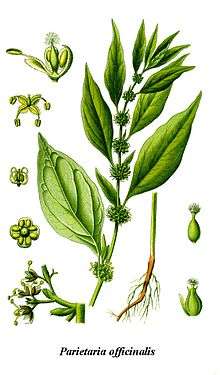Parietaria officinalis
| Parietaria officinalis | |
|---|---|
 | |
| Scientific classification | |
| Kingdom: | Plantae |
| (unranked): | Angiosperms |
| (unranked): | Eudicots |
| (unranked): | Rosids |
| Order: | Rosales |
| Family: | Urticaceae |
| Genus: | Parietaria |
| Species: | P. officinalis |
| Binomial name | |
| Parietaria officinalis L. | |
Parietaria officinalis, the eastern pellitory-of-the-wall,[1] also known as upright pellitory[2] and lichwort, is a plant of the nettle family. Its leaves, however, are non-stinging. The plant grows on rubbish and on walls, hence the name.
The pollen is a cause of allergy.[3]
Uses
It was once used in the making of certain metheglins.
Chemistry
The leaves and flowers of P. officianlis contains the flavonoids kaempferol-3-bioside, the 3-glucosides and 3-rutinosides of quercetin, kaempferol and isorhamnetin, 3-sophorosides of quercetin and kaempferol and 3-neohesperosides of kaempferol and isorhamnetin.[4] They also contains caffeoylmalic and two pyrrole acids.[5]
See also
It is in a different family from Anacyclus pyrethrum, also called pellitory.
References
- ↑ "BSBI List 2007". Botanical Society of Britain and Ireland. Archived from the original (xls) on 2015-02-25. Retrieved 2014-10-17.
- ↑ "Parietaria officinalis". Natural Resources Conservation Service PLANTS Database. USDA. Retrieved 30 January 2016.
- ↑ Specific hyposensitization in patients allergic to Parietaria officinalis pollen allergen. Cvitanović S, Zekan L, Capkun V and Marusić M, Journal of Investigational Allergology & Clinical Immunology, 1994, volume 4, issue 6, pages 283-290, PMID 7735515
- ↑ Flavonoids of Parietaria officinalis. J. Budzianowki, L. Skrzypczak and D. Walkowiak, J. Nat. Prod., 1985, 48 (2), pages 336–337, doi:10.1021/np50038a033
- ↑ Caffeoylmalic and two pyrrole acids from Parietaria officinalis. Jaromir Budzianowski, Phytochemistry, 1990, Volume 29, Issue 10, pages 3299–3301, doi:10.1016/0031-9422(90)80203-S
- "w19 Wall pellitory (officinalis), Allergy information". Phadia AB. 2002. Archived from the original on 2006-05-23. Retrieved 2006-07-08.
External links
 "Pellitory". Encyclopædia Britannica (11th ed.). 1911.
"Pellitory". Encyclopædia Britannica (11th ed.). 1911.
This article is issued from Wikipedia - version of the 10/5/2016. The text is available under the Creative Commons Attribution/Share Alike but additional terms may apply for the media files.